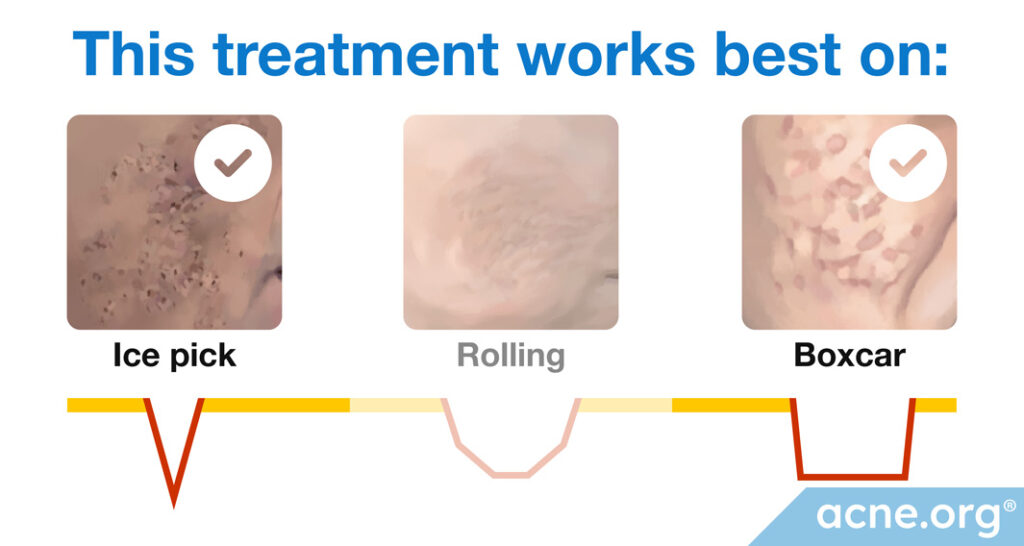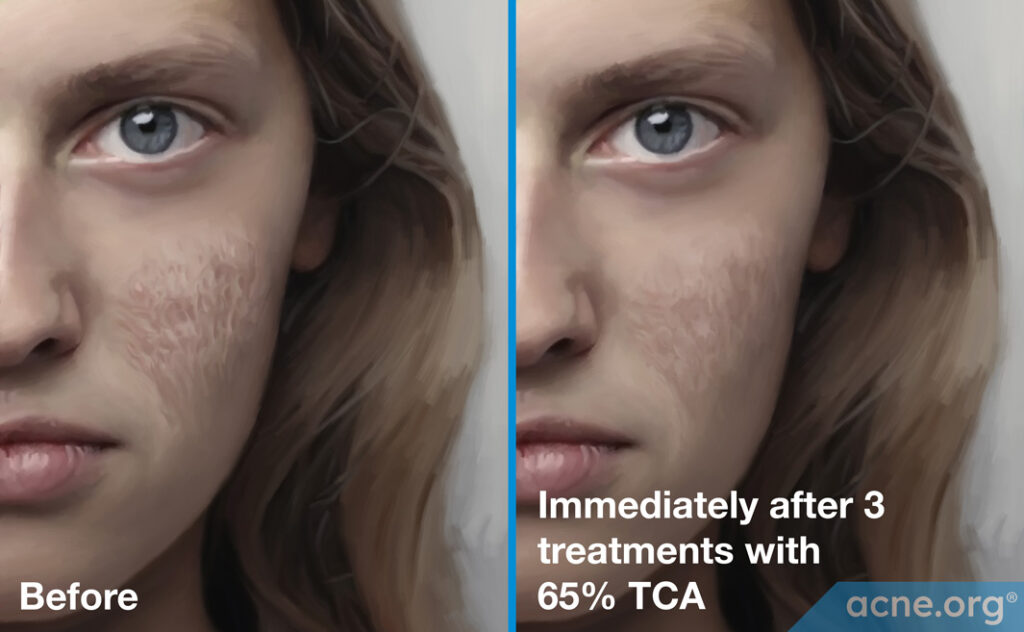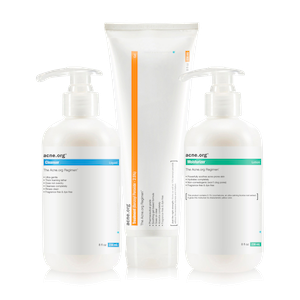
* The CROSS technique is most effective for ice pick and boxcar scars if the scars are narrow.
CROSS stands for the Chemical Reconstruction Of Skin Scars, and is sometimes referred to as TCA CROSS.1 It is a technique for applying a chemical peel to atrophic (indented) acne scars in a targeted fashion while sparing the healthy skin around the scars. In CROSS, a doctor uses a toothpick-like wooden applicator to press a concentrated chemical mixture into an individual acne scar for several seconds. However, more recently, doctors have also started injecting chemical peel solution directly into the scars. Whether it is applied with a toothpick or injected, the chemical peel solution creates a localized, controlled injury that will cause the skin to peel off and will stimulate the growth of thicker new skin in its place.1,2 The same procedure is repeated for each scar.
The CROSS technique was invented in 2002 by Dr. Lee and colleagues, a group of dermatologists who wanted to use chemical peels in a way that would maximize scar improvement while reducing the risk of side effects.2
Because chemicals are applied only to scars and not to the surrounding healthy skin, doctors can use very strong chemicals that cause deep damage.1 These chemicals corrode (eat away at) several skin layers: the epidermis, the papillary dermis, and about half of an even deeper skin layer called the reticular dermis. This is why the CROSS technique is best suited for deep acne scars such as icepick scars.
Multiple (3-4) treatments with the CROSS technique at 4-week intervals may be necessary to obtain desired results.1
As with all scar revision treatments, the CROSS technique is sometimes combined with other scar revision procedures to achieve desired results.
People with active acne should not undergo acne scar repair of any kind, including the CROSS technique. Ensure that your skin is clear of acne before beginning scar treatment.
Before agreeing to undergo treatment with the CROSS technique, talk to multiple doctors about their opinions, proposed treatments, expected outcomes, and prices.
Procedure details:

A sharpened wooden applicator or injection is used to press/inject chemicals into acne scars.
The chemical most often used in the CROSS technique is trichloroacetic acid (TCA), in the concentrations normally reserved for deep chemical peels, at 50% or higher. However, in rare instances, doctors may opt for another extremely strong chemical used only in deep chemical peels called phenol.1,2,4
The doctor uses a sharp wooden applicator, similar to a toothpick, to press the chemicals into acne scars one at a time. With the other hand, the doctor simultaneously stretches the skin around the scar to ensure the applicator reaches the bottom of the scar and to prevent the chemicals from coming into contact with the surrounding healthy skin.2,5 After the application of a TCA peel, a characteristic white “frost” appears on the skin.1,2
Alternatively, the doctor uses a small syringe filled with TCA solution and injects it into the scar base with slight pressure until frosting is achieved.6
Anesthesia:
Most patients experience some burning and/or stinging during treatment with the CROSS technique. CROSS is usually performed without any anesthesia, but in some cases, the doctor may use a local anesthetic to numb the skin before beginning the procedure.
Before-and-after:

Acne scars before (left) and after (right) three treatments with 65% TCA.
References
- Kontochristopoulos G, and Platsidaki E. Chemical peels in active acne and acne scars. Clin Dermatol. 35(2), 179-182 (2017).
- Lee JB, Chung WG, Kwahck H, and Lee KH. Focal treatment of acne scars with trichloroacetic acid: chemical reconstruction of skin scars method. Dermatol Surg. 28(11), 1017-21 (2002).
- Bhardwaj D, and Khunger N. An Assessment of the Efficacy and Safety of CROSS Technique with 100% TCA in the Management of Ice Pick Acne Scars. J Cutan Aesthet Surg. 3(2), 93-6 (2010).
- Ramadan SA, El-Komy MH, Bassiouny DA, and El-Tobshy SA. Subcision versus 100% trichloroacetic acid in the treatment of rolling acne scars. Dermatol Surg. 37(5), 626-33 (2011).
- Agarwal N, Gupta LK, Khare AK, Kuldeep CM, and Mittal A. Therapeutic response of 70% trichloroacetic acid CROSS in atrophic acne scars. Dermatol Surg. 41(5), 597-604 (2015).
- Horovitz T, Salameh F, Shehadeh W, Koren A, Artzi O. Painting CROSS TCA technique: Modification of the CROSS method for the treatment of atrophic acne scars-Case series. J Cosmet Dermatol. 21(1), 327-30 (2022).
Future reading
- Ahmed R, Mohammed G, Ismail N, and Elakhras A. Randomized clinical trial of CO₂ LASER pinpoint irradiation technique versus chemical reconstruction of skin scars (CROSS) in treating ice pick acne scars. J Cosmet Laser Ther. 16(1), 8-13 (2014).
- Khunger N, Bhardwaj D, and Khunger M. Evaluation of CROSS technique with 100% TCA in the management of ice pick acne scars in darker skin types. J Cosmet Dermatol. 10(1), 51-7 (2011).
- Nofal E, Helmy A, Nofal A, Alakad R, and Nasr M. Platelet-rich plasma versus CROSS technique with 100% trichloroacetic acid versus combined skin needling and platelet rich plasma in the treatment of atrophic acne scars: a comparative study. Dermatol Surg. 40(8), 864-73 (2014).
- Dalpizzol M, Weber MB, Mattiazzi AP, and Manzoni AP. Comparative Study of the Use of Trichloroacetic Acid and Phenolic Acid in the Treatment of Atrophic-Type Acne Scars. Dermatol Surg. 42(3), 377-83 (2016).
 Acne.org Products
Acne.org Products